There’s a hill in Maldonado, Uruguay, called Pan de Azucar (sugar loaf), that you can easily spot if you drive by, it’s the one with a cross on top. This place hosts a national park, suitable for picnics, a zoo with typical Uruguayan fauna reservation, and of course the hill. Not being a particular animal lover, I find the hill itself to be the main attraction, since it makes for a very enjoyable hillwalking tour.
I went last Friday, and it was like the fourth time I climbed it in my life. I did it a couple of times with my parents, as a kid, and about five years ago with my girlfriend, and it’s remarkable how it mirrors aging for this time was the first time I really felt the exercise.
The hill is 423 meters high, and is actually the third highest in Uruguay. It’s a two to three hour trip, to get to the top and return. It’s not difficult but it’s not trivial either, some parts of the trail are pretty steep to be done walking, and you have to help yourself with your hands to make sure you don’t slip.
On top of the hill there’s a concrete 35 meter high cross. It has a staircase and you can climb to the arms of the cross and enjoy a panoramic view of the coast of Maldonado, including piriapolis and punta del este.
...
Sunday, March 23, 2008
Hillwalking in Uruguay, Pan de Azucar
Posted by
gabouy
at
8:38 PM
113
comments
![]()
Labels: Places
Sunday, September 30, 2007
Camping in Santa Teresa
I came across this video about Santa Teresa in youtube, which looks like it was created by brazilian surfers and I couldn´t help posting it. It pretty much resembles some of my own memories.If you are into surf & camping and happen to be in Uruguay in summer don´t miss it. ...
Posted by
gabouy
at
3:54 PM
47
comments
![]()
Labels: Places
Wednesday, August 08, 2007
Uruguay Places, Colonia de Sacramento
We’ve recently been to Colonia de Sacramento, Uruguay with my girlfriend, and I feel like paying a tribute post to the place. If you’ve never heard of it, check out the post where I introduce Colonia in this blog. It’s basically one of the top five places worth visiting in Uruguay.
Sometimes when we feel like recharging batteries we go to Colonia de Sacramento. It’s the sort of place you go when you want to escape from the city, noise, technology, etc. Make sure to take your special someone and a good book. That’s pretty much all is needed to spend a great weekend there.
What do you do there? Well, you walk the cobbledstone streets. You browse the crafts offered by the artisans, you enjoy the sun in the mini port, you eat some sea food. You dine in some romantic, candle lighted, stone walled restaurants.
You probably don’t want to be there more than two, or three days or you may get bored.
It caught my attention the number of tourist we saw there this time, we could hear English, French, and German being spoken at our sides. It's been always a very touristic place, but argentineans used to be the only foreigners around. Now the place seems so much more cosmopolite, I guess it's been included in the visit buenos aires one week circuit.
We stayed in a little familiar place, called Hotel Leoncia for 55 bucks a night. The place is not great, it's ok, and we had dinner in a place in the historic part of the city for around 27 usd both of us.
Here are some pictures of our retreat to Colonia...
...
Posted by
gabouy
at
4:07 PM
27
comments
![]()
Labels: Places
Tuesday, March 27, 2007
Montevideo's Harbor (in Black and White)
Montevideo's harbor (aka "el puerto de montevideo") is a very interesting place, but unfortunately access is restricted. I was lucky to get in and take pictures because I am entering a photography contest and was given a special permission and a tour guide to walk around. These pictures describe the harbor and its people, their work and their breaks.
Please full view them by clicking on the thumbnail, you will appreciate the scenes much better. I might add a couple more in about a week or so because I will go back to take some more so if you like them come back for more! Hope you enjoy them...






 ...
...
Posted by
Tali
at
11:11 AM
9
comments
![]()
Labels: General Info, pictures, Places
Thursday, February 22, 2007
Parque del Plata, Canelones
I've spent the last few days in Parque del Plata, Canelones, Uruguay, along with my familiy for the carnival holidays.
Parque del Plata is one of a series of beachside villas/towns (balnearios) by the coast of Canelones. All of them very peaceful, green, with nice beaches, reasonably good renting prices, and most important around 50km from Montevideo. They make for good weekend escape spots.
These are not trendy places, like Punta del Diablo, Cabo Polonio, or Punta del Este, but still they are nice and have good beaches. Some of them are Marindia, Atlantida, Las Toscas, Parque del Plata, La Floresta.
All this places are kinda dead during most of the year and come alive in the summer season. Atlantida is the biggest of them all, and the one with best nightlife, restaurants, pubs and discos. It is also the place where El Aguila is located.
In particular Parque del Plata, and Atlantida host an increasing amount of retired couples that are choosing to live all the year in these places, escaping from the city.
Parque del Plata has some of the best dunes in the coast of Uruguay, that is why is not uncommon to see people practicing sandboard in the beach.
By the way I'm a brand new uncle (hooray!). In the following slideshow you get to see my mother proudly walking her three weeks old granddaughter, Maria Lucia.
...
Posted by
gabouy
at
5:51 PM
9
comments
![]()
Labels: Places
Monday, January 29, 2007
Punta del Diablo, Rocha, Uruguay

I don't know how to put it, but the place is weird, like good weird, is like is not Uruguay. I remember the first time I went there, after a lengthy walk from Santa Teresa around seven years ago, it struck me the scene I've found there, like nothing I had seen before in my country. I saw shored fishing boats by the beach, one little pub playing reggae, plus like about a block of hippie stands in a row, selling handcrafted earrings, collars, and such, close to a peninsula shaped by big rocks.
Nobody knew the place ten years ago, while now in summer a rent there is about 60 bucks a day, for a crumbling small ranch, close to the beach. This year I even spotted some foreign tourists, which was unheard of some years ago.
Even though it's getting trendy, and more sophisticated, it still retains the jamaica no problem vibe, with the hippie little shops, surfers, seafood restaurants, lack of paved roads, and everybody in summerwear style.
If you go there you must try "Buñuelos de alga" (something like seaweed fritters, or fried doughs), since it´s the specialty of the town.
Check what Chuck Stull in his blog writes about it.
The few pictures I have were taken in the afternoon, and in cloudy days, so they are no the best, but I hope you'll find them illustrative.
...
Posted by
gabouy
at
7:24 PM
12
comments
![]()
Labels: Places
Thursday, January 18, 2007
Cabo Polonio, Rocha
There's a place in Rocha, Uruguay, called Cabo Polonio. I've never been there myself, but I've always heard all sort of things about it, some people love it, they says it's a unique place in the world, while others can't stand the lack of civilization and services there.
The fact is that there this place called Cabo Polonio, that can't be reached by car, it's about 7 km from the closest highway, people get there walking that distance, or in all terrain vehicles. Another way to get there is by the beach, in a 3 hour walk from Valizas.
There you can find: sea lions, a lighthouse, the beach, and sand dunes. The place has no electricity, no running water, few and rustic constructions. The funny thing is that from january to march it gets crowded with tourists, and the rents are sky high, even though almost no basic services are provided.
Topless is a common practice there, and even some nudity, or so they say. My girlfriend says she saw there (I hope from far away) some guys playing beach soccer in the nude. Well that's the type of things you don't see everyday.
I came across this articles about Cabo Polonio in Uruguay, in gaston in suecia's blog, which has some nice pictures, and I think captures what seems to be the escence of Cabo Polonio....
Posted by
gabouy
at
4:19 PM
25
comments
![]()
Labels: Places
Sunday, January 14, 2007
Santa Teresa, Rocha, Uruguay

In the region of Rocha, Uruguay, more specifically at the km 302 of the 9 route, there's a national park called Santa Teresa. The place is a beautiful forest with some of the best beaches this country has to offer.
<<previous
The park is named after a hilltop fortress built in the 1762 by the Portuguese, early captured and finished by the Spaniards. The place has witnessed battles between Spanish and Portuguese, Spanish and British, and civil wars. The fort has been restored and is one of the attractions to visit in the park.
Santa Teresa has wide area available for tent camping, and has some bungalows to rent. It's very popular among camping fans. It's ridiculously cheap to camp there, one parcel that can be used by up to 7 guys, costs 150 pesos, about 6 american bucks. Being so affordable it gets crammed with youth in summer, well, not really crammed, the place is 1054 hectares wide (2064 acres), so it's big enough to host an army of camping fans. The beaches are great, oceanic, big waves (in uruguayan terms) I'd say waves up to 2 meters tall, surfing is a popular sport there.
The place is run by the army, and management is not very good. The supermarkets (there are 2 of them) run out of supplies rather quick, and if you ask "where can I find a free spot to camp?" you won't get very clear directions. On the other hand the place is safe like no other, and the park is very well taken care of.
Santa Teresa is a very popular destination for the uruguayan middle class, surfers, and teenagers, providing a good blend of natural resources, peace, safety, adventure and low costs. It's a humble type of tourism, the spirit among the campers is of camaradery, usually older campers (families) lend the tools to the groups of unequipped teenagers that try the camping experience. It also attracts a great deal of tourists from the south of Brazil, and from Argentina, in particular people from Cordoba.
The park is only 5 km away from Punta del Diablo, another seaside tourism hotspot in Rocha, and about 30 km to the border with Brazil, El Chuy, a border town with half a dozen of duty-free shops. Actually the trip to Punta del Diablo can be done by the beach which is one of the popular things to do there, in a walk of a couple of hours.
It's a place I'm very fond of, which I visited all my life, first as a kid with my parents, and later on, in my teenage years, we would go there with a bunch of friends every summer. When I think of Santa Teresa, lot of memories come to my mind, memories of campfires, beach soccer, walking in the beach for hours, fetching wood, making up excuses to visit the girl's neighbor camp, the night as one mantle of stars above the trees, hideous toilets, hitchhiking back to Montevideo for hours, and so on.
Here is a photo album that I hope will help you understand what's Santa Teresa like,
...
Posted by
gabouy
at
2:21 PM
143
comments
![]()
Labels: Places
Sunday, December 24, 2006
La Rambla
| From La Rambla |
| <<previous | next>> |
La Rambla goes from Ciudad Vieja to Carrasco in Montevideo, the most popular part of it is the Pocitos's neigborhood one, La Rambla de Pocitos.
It's the favorite place for montevideans to chill out, have a beer, or mate with bizcochos along with friends, or family, specially in spring and summer time. It's also a great place for doing some sports, like: jogging, biking, fishing, beach volley, beach football, or just walk.
Some say is what Buenos Aires lacks, and porteños envy the most of montevideans, but I'm not sure about that. I'll just leave you with a photo album, that I hope explains better what the Rambla is all about...
By the way, merry xmas! ...
Posted by
gabouy
at
2:40 PM
43
comments
![]()
Labels: Places
Tuesday, May 23, 2006
La Posta del Chuy, Cerro Largo
<<previous
next>>
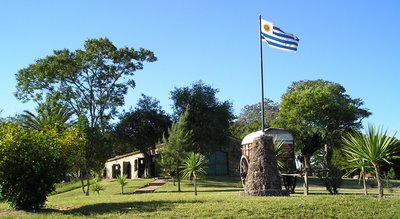
In the middle of the XIX century the brand new Uruguayan state in an attempt to populate the lands near the border with Brazil, and not being able to finance the cost of road works, gives the concesion to privates of the building of a bridge over the creek "Chuy del Tacuarí", on the path that communicated the city of Melo with Rio Branco (in those years called “Villa Artigas”).
Those who wanted to cross that bridge, had to pay a toll.
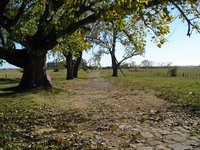 The building of the bridge and the nearby facilities, was leaded by the men that years later would rebuild the “Fortaleza de Santa Teresa” (Saint Teresa Fortress), the “Fortaleza del Cerro de Montevideo”(Cerro of Montevideo Fortress) and the “Fuerte de San Miguel” (Saint Michael Fort).
The building of the bridge and the nearby facilities, was leaded by the men that years later would rebuild the “Fortaleza de Santa Teresa” (Saint Teresa Fortress), the “Fortaleza del Cerro de Montevideo”(Cerro of Montevideo Fortress) and the “Fuerte de San Miguel” (Saint Michael Fort).
The bridge has loopholes in its sides, something essential given the dangers of those years and the proximity of the Brazilian border. The building's style was very common in the Basque Country. Also, next to it, there was constructed a hostal, a “Pulpería” (like a inn, but actually a bit more like a social center and a place to buy supplies) and a horse relay service.
Over the bridge, a heavy iron chain was always extended, and only was lowered after paying… and ancient version of our current “peajes” and their black and yellow barriers.
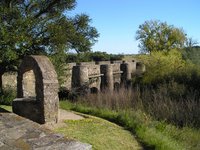 The first owners (actually concessionaires), Spanish Basques, were known by the towering fees they collect, often over what said the law. As an example of it, it is said that the fee by law for a carriage was 4 cents and 1 cent for people, but they retrieve 5 cents… 4 for the carriage and 1 for the driver… as if the carriage could pass alone.
The first owners (actually concessionaires), Spanish Basques, were known by the towering fees they collect, often over what said the law. As an example of it, it is said that the fee by law for a carriage was 4 cents and 1 cent for people, but they retrieve 5 cents… 4 for the carriage and 1 for the driver… as if the carriage could pass alone.
The facilities were usufructed till 1919, when the government decided to put an end to the concession, because in that moment all the roads in the country were free.
Later, and after some reparations to the stone structures, the Posta del Chuy became a museum and received the status of historical patrimony of the country.
There you can see replicas of advertisements and the routes covered by some coaches… journeys of about 20 days that nowadays are covered in 4 hours by car.
The place is well preserved and remains as a glimpse of what used to be life one hundred and half years ago over here.
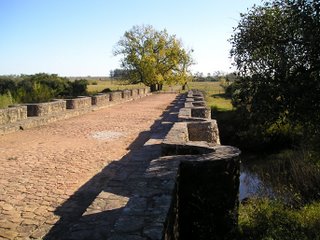
Posted by
gabouy
at
7:31 PM
30
comments
![]()
Labels: Places
Monday, April 10, 2006
Trekking in la Sierra de las Animas, Maldonado
<<previous
next>>
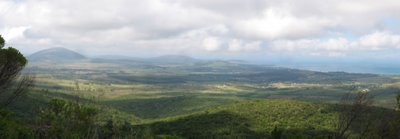 La Sierra de las Animas is the name of a couple of hills in Maldonado (actually a sierra) of no more than 508 meters high (did I ever mention that Uruguay is a flat country?). It's actually the second highest "peak" in Uruguay, being the first one el cerro catedral with something like ten more meters high, not much more (dont take my word for it, go get some encyclopedia and correct me).
La Sierra de las Animas is the name of a couple of hills in Maldonado (actually a sierra) of no more than 508 meters high (did I ever mention that Uruguay is a flat country?). It's actually the second highest "peak" in Uruguay, being the first one el cerro catedral with something like ten more meters high, not much more (dont take my word for it, go get some encyclopedia and correct me).
It's a very popular trekking spot in Uruguay, there are a couple of different walks to choose from. The one we did was to make it to the top of the hill, which is about a two to three hour walk, but there is also another one called "El cañadon de los espejos". The last one is named after pools of rainwater with small waterfalls you arrive to when you reach to the end of the path. The place is said to be very beautiful after rainy days with the waterfalls in their full glamour.
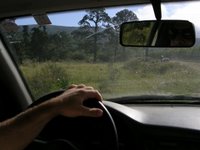
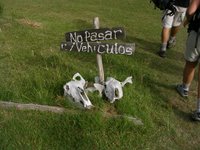
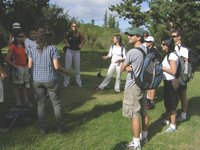
There used to be a third walk to the "pozos azules" (or blue pools) which is now closed, and there is also a whole discussion about which ones are the true legendary blue pools which I won't go into.
La Sierra de las Animas is also very popular among mountain bikers who carry their bikes to the top and then slide from there.
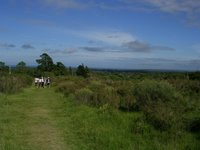


Once we arrived to the place we payed the 40 uruguayan pesos fee, and listened carefully to the pleasetakegoodcareofthepark fifteen minutes lecture. The place is maintained as an ecological park and we learned that it's forbidden even to spit fruit seeds while walking in order to protect the original flora (killing anything that walks or crawls or flies is of course out of the question).



When you are on the top of the hill you understand why they used to call it Mirador Nacional (National watcher...err, no.. watchpost, sightseer...err, something like that) as you can see a great part of Maldonado and even Montevideo or so they say in clear days.
We crossed a bunch of horses on the way to the top, and one snake and one impressive tarantula on the way down.

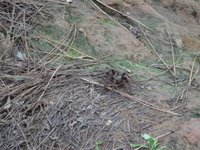

If you are the kind of person that likes walking, watching nature and just talking with someone in the way to the top (to the peak) you probably would've enjoyed it.

...
Posted by
gabouy
at
5:06 PM
30
comments
![]()
Labels: Places
Monday, January 16, 2006
It's summer time, not much sun though
<<previous
next>>

First half of january is over, typically the best days in the year to go on vacations in Uruguay. Usually the best weather days in the whole year, when every teenage girl takes like twelve daily hours of suntan, until it hurts, literally. Even though in this corner of the world it's highly adviced against sunbathing between eleven am to three, because of the ozone layer hole, you know...sun hurts, didn't used to, but now it does, shame on polluting countries! But not this year, nope, the first half of january's been more like... is it really january? is this rain stopping, ever? when are the clouds going to leave?
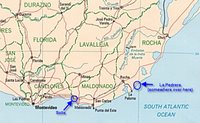 Here are some pictures taken in La Pedrera, Rocha, and Solis, Maldonado. Well, yeah, there are a lot places to go on vacations in Uruguay, besides Punta del Este, which is the only one that people seem to talk about. While Punta del Este is more of a high profile beachside, resort, there are a lot of places, specially in Rocha, but also in Maldonado and Canelones, that are pretty good to spend some days lying on the beach, reading, taking naps, swiming, fishing doing whatever but working. In particular, in Rocha, it's where the best beaches are and where less populated is. People go there camping, or stay in rented houses, sometimes, even fishermen hutslike houses. In winter, most of those places are deserted, which is why a lot of people like to go off season, typically in december, or march.
Here are some pictures taken in La Pedrera, Rocha, and Solis, Maldonado. Well, yeah, there are a lot places to go on vacations in Uruguay, besides Punta del Este, which is the only one that people seem to talk about. While Punta del Este is more of a high profile beachside, resort, there are a lot of places, specially in Rocha, but also in Maldonado and Canelones, that are pretty good to spend some days lying on the beach, reading, taking naps, swiming, fishing doing whatever but working. In particular, in Rocha, it's where the best beaches are and where less populated is. People go there camping, or stay in rented houses, sometimes, even fishermen hutslike houses. In winter, most of those places are deserted, which is why a lot of people like to go off season, typically in december, or march.
enjoy the pics!
La Pedrera



Solís
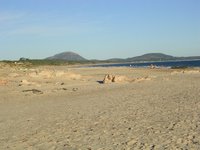
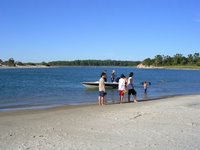
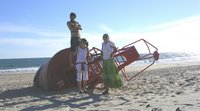 ...
...
Posted by
gabouy
at
2:05 PM
11
comments
![]()
Labels: Places
Sunday, December 04, 2005
Places, Canelones, Atlantida, El águila
<<previous
next>>
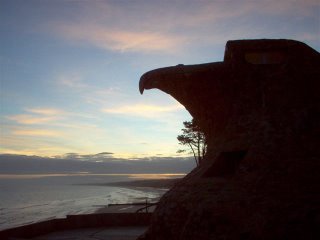 There is one weird building standing in the Uruguayan coast of Canelones, Atlantida.
There is one weird building standing in the Uruguayan coast of Canelones, Atlantida.
If you have time to do some beach walking, starting from Atlantida’s calm beach, (“la playa mansa”) and heading west you’ll notice after a five minute walk, this rock among the pine trees coastline. In no time you’ll realize it’s the head of an eagle you’re looking at.
This building is one of  the typical sights of Atlantida, and in my mind it’s been there since forever. The whole construction is shrouded in a haze of myths, about its origins and purposes. The most spread one is that it was built as a Nazi watch post, in the Second World War to monitor the river plate river. It’s a known fact that there were Nazis in the river plate region during the Second World War, and the eagle shape help the mystery gain credibility.
the typical sights of Atlantida, and in my mind it’s been there since forever. The whole construction is shrouded in a haze of myths, about its origins and purposes. The most spread one is that it was built as a Nazi watch post, in the Second World War to monitor the river plate river. It’s a known fact that there were Nazis in the river plate region during the Second World War, and the eagle shape help the mystery gain credibility.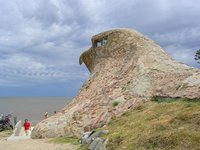 I must admit that there’s something elegant and surreal to an eagle shaped rock constantly watching the horizon, it feels as some old civilization ruin left over (it helped the fact that until one year ago the place actually was in ruins, the thing was a wreck).
I must admit that there’s something elegant and surreal to an eagle shaped rock constantly watching the horizon, it feels as some old civilization ruin left over (it helped the fact that until one year ago the place actually was in ruins, the thing was a wreck).
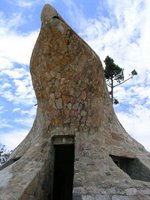 One year ago the national tourism office realized something had to be done about it falling apart, and restored it, at least partially. In restoring it, they also killed the myths as now you can read posts telling the official construction’s story. It seems in the year 1945 one Italian rich guy called Michelizzi owner of one seaside house, ordered the construction of a small shrine by the beach, to consecrate it to the virgin. The constructor in charge, named Torres, built something twice as large as indicated and when Mr Michelizzi saw the place, and the view it had, he decided to dedicate it to reading, and painting instead, and as a whim he ordered the construction of an eagle on top of it, covered in stones as feathers. When it was finished he liked it so much that the he told Torres to continue his work building something in the shape of a naval ship underneath. Michelizzi died in 1957, and the sea completely destroyed the ship part of the building, leaving only the eagle.
One year ago the national tourism office realized something had to be done about it falling apart, and restored it, at least partially. In restoring it, they also killed the myths as now you can read posts telling the official construction’s story. It seems in the year 1945 one Italian rich guy called Michelizzi owner of one seaside house, ordered the construction of a small shrine by the beach, to consecrate it to the virgin. The constructor in charge, named Torres, built something twice as large as indicated and when Mr Michelizzi saw the place, and the view it had, he decided to dedicate it to reading, and painting instead, and as a whim he ordered the construction of an eagle on top of it, covered in stones as feathers. When it was finished he liked it so much that the he told Torres to continue his work building something in the shape of a naval ship underneath. Michelizzi died in 1957, and the sea completely destroyed the ship part of the building, leaving only the eagle.

Although now I know the true story, I can’t help thinking of it surrounded in mysterious plots of war, spies, and a time that is no more.
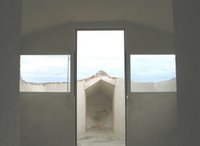 Now it’s open to the public, you can go in it, walk up the stairs and appreciate the view from within the eagle’s head. They even light it up at night, in a way that it seems it has its eyes opened.
Now it’s open to the public, you can go in it, walk up the stairs and appreciate the view from within the eagle’s head. They even light it up at night, in a way that it seems it has its eyes opened.

...
Posted by
gabouy
at
7:43 AM
14
comments
![]()
Labels: Places
Sunday, November 13, 2005
Tristan Narvaja, the largest uruguayan flea market
<<previous
next>>
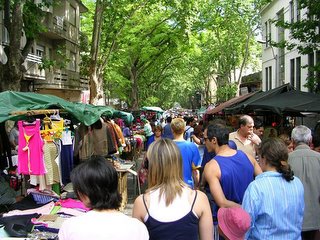
 Every sunday morning takes place the largest flea market in Uruguay, named after the street where it's located.La feria de tristan narvaja is the kinda place where you can find everything, ranging from tarantula like spiders, parrots, old comic magazines, groceries, books, arts & crafts, old vinyl records, old tv and radio sets, antiques, to the latest pirate piece of software. I guess, "eclectic" is the most suitable word for the place.
Every sunday morning takes place the largest flea market in Uruguay, named after the street where it's located.La feria de tristan narvaja is the kinda place where you can find everything, ranging from tarantula like spiders, parrots, old comic magazines, groceries, books, arts & crafts, old vinyl records, old tv and radio sets, antiques, to the latest pirate piece of software. I guess, "eclectic" is the most suitable word for the place.
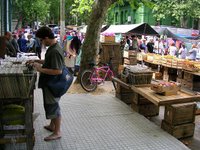 It's the land of the collectionist and the pick-pocketer, a place where you can find the neighbor buying the week's stock of groceries, the ocassional madman shouting, the street beggar begging, and the reseller looking for some undervalued item. A human zoo of sorts, a uruguayan gallery of sights, sounds and scents. It's in some way the negative of a shopping center.
It's the land of the collectionist and the pick-pocketer, a place where you can find the neighbor buying the week's stock of groceries, the ocassional madman shouting, the street beggar begging, and the reseller looking for some undervalued item. A human zoo of sorts, a uruguayan gallery of sights, sounds and scents. It's in some way the negative of a shopping center.
 The market is placed all along the tristan narvaja street, which is about one kilometer, and extends to every crossing and paralell street. While the backbone of the market takes place in tristan narvaja st, it is in the periphery where it is more likely to find hidden "treasures", laid on blankets on the street. It is also in the periphery where is less secure, and is a more fertile ground for street scams.
The market is placed all along the tristan narvaja street, which is about one kilometer, and extends to every crossing and paralell street. While the backbone of the market takes place in tristan narvaja st, it is in the periphery where it is more likely to find hidden "treasures", laid on blankets on the street. It is also in the periphery where is less secure, and is a more fertile ground for street scams.
 There is even one uruguayan urban myth that talks about one "torres garcia", a painting from one of the most famous uruguayan paintors was actually found and bought here for nothing. There is also another myth about an stradivarius being found here, but the latter I find harder to believe.
There is even one uruguayan urban myth that talks about one "torres garcia", a painting from one of the most famous uruguayan paintors was actually found and bought here for nothing. There is also another myth about an stradivarius being found here, but the latter I find harder to believe.
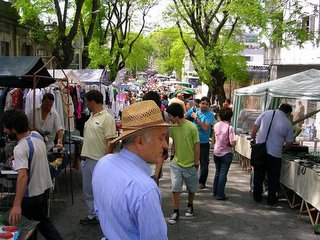
...
Posted by
gabouy
at
12:03 PM
144
comments
![]()
Friday, October 21, 2005
Colonia do Sacramento
<<previous
next>>

 Located at the south west end of the land, Colonia do Sacramento is the oldest city in Uruguay or err... mmm, maybe the oldest city in Uruguay, or one of the oldests cities in uruguay, anyway. The fact is that in 1680 the portuguese founded this city, and that's prior to the foundation of our capital Montevideo, in fact Montevideo was founded as a countermeasure of the Spanish empire (not darth vader's one) to stop the portuguese advance. The history of Uruguay's colonization is a continuous struggle between the spanish forces against the portuguese, with some intrusion of the british (when not?) to take over this chunk of land in the world. Colonia went from portuguese creation, to spanish domination, then back again to portuguese or brazilian, depending on the year, and back again, times N, until Uruguay as an indepenant country was born. This is why the historical part of the city has blend of spanish and portuguese architectural styles which is kinda nice.
Located at the south west end of the land, Colonia do Sacramento is the oldest city in Uruguay or err... mmm, maybe the oldest city in Uruguay, or one of the oldests cities in uruguay, anyway. The fact is that in 1680 the portuguese founded this city, and that's prior to the foundation of our capital Montevideo, in fact Montevideo was founded as a countermeasure of the Spanish empire (not darth vader's one) to stop the portuguese advance. The history of Uruguay's colonization is a continuous struggle between the spanish forces against the portuguese, with some intrusion of the british (when not?) to take over this chunk of land in the world. Colonia went from portuguese creation, to spanish domination, then back again to portuguese or brazilian, depending on the year, and back again, times N, until Uruguay as an indepenant country was born. This is why the historical part of the city has blend of spanish and portuguese architectural styles which is kinda nice.
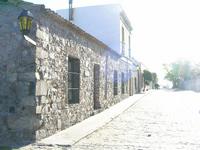
The historical parts of the citiy were declared common heritage of the human kind by the unesco, some time ago, and it's right now one of the turistic spots of the country.
The historical part of the city it's small, you can make it by feet, it keeps it's original disarranged cobblestoned streets, and houses.

It's a good place for example to spend a weekend in couple, as it's beautiful, quiet, and there lots hotels in the whole area, some of them reasonably cheap and good. Let's put it this way it's not famous for it's wild night life.
...
Posted by
gabouy
at
5:01 PM
11
comments
![]()
Labels: Places

